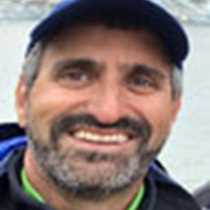Boca de Soledad, Magdalena Bay
Gray Whale. Eschrichtius robustus. Mussel digger. Devil-fish. Hardhead. Scragwhale. Desert whale. Ripsack. “Cross ‘tween a Sea-serpent and an Alligator.” “Being with the Itchy Face.” “Mass that Moves Upon the Seas.” “That Which Dances in the Clouds.”
Only bottom-feeding great whale. Laden with barnacles and whale lice. Longest migrating mammal. Only member of its genus and family. Uncertain evolution. Never in the southern hemisphere. Extinct in the north Atlantic. Hunted to near extinction in the north Pacific. Recovered sufficiently to be removed from the endangered species list. “Friendly” behavior with humans today.
The legacy of the California gray whale carried on today as a new generation of whales toured Magdalena Bay with their mothers, swimming against flood and ebb and approaching Zodiacs. A brisk breeze off the Pacific stirred the turbid green waters of the dune-enclosed lagoon system as we embarked from the Sea Lion for a day of cruises among the whales. The ship served as our tidal clock, turning about her anchor every six hours with strong full moon tides.
Out in the Boca we ventured to observe the flow of whales in and out of the bay. Mothers took calves for their first visits out of protected waters or just ran them against strong currents to strengthen up for an imminent migration. We enjoyed exhilarating rides in the dancing waters, turning our backs on misty clouds of breath that baptized us as whales popped up and blew between the boats. Calves rolled off their mothers’ backs upside down and single adults disappeared as fast as they appeared, fluking up abruptly as they became mere memory.
Within the protected canal waters, we floated among loosely associated groups of mothers and calves lazily riding upstream. Baby whales lunged head high up out of the water and opened their mouths to show off curtains of baleen. An absolute highlight was the curiosity exhibited by a “friendly” calf that made intimate sorties with our Zodiacs.
Undulating wind-curved dunes provided nice backdrop to our excursions. A cloud of brown pelicans lifted up off a sand bar as a pair of bald eagles came in overhead. Coyotes trotted over the dunes, and herons and egrets roosted in the mangroves. Frigatebirds took advantage of work done by bottlenose dolphins herding prey in shallows, delicately plucking fish off the surface with their bills.
The baby whales will soon depart these desert canals to follow the contours of the western seaboard of North America to Arctic summering seas. They must venture a fifth of the way across the planet, avoiding the killer whales of Monterey Canyon and other hazards before reaching abundant food resources. Another contingent of humans is rooting them on, having been indoctrinated this week to the legacy of the California gray whale.
Gray Whale. Eschrichtius robustus. Mussel digger. Devil-fish. Hardhead. Scragwhale. Desert whale. Ripsack. “Cross ‘tween a Sea-serpent and an Alligator.” “Being with the Itchy Face.” “Mass that Moves Upon the Seas.” “That Which Dances in the Clouds.”
Only bottom-feeding great whale. Laden with barnacles and whale lice. Longest migrating mammal. Only member of its genus and family. Uncertain evolution. Never in the southern hemisphere. Extinct in the north Atlantic. Hunted to near extinction in the north Pacific. Recovered sufficiently to be removed from the endangered species list. “Friendly” behavior with humans today.
The legacy of the California gray whale carried on today as a new generation of whales toured Magdalena Bay with their mothers, swimming against flood and ebb and approaching Zodiacs. A brisk breeze off the Pacific stirred the turbid green waters of the dune-enclosed lagoon system as we embarked from the Sea Lion for a day of cruises among the whales. The ship served as our tidal clock, turning about her anchor every six hours with strong full moon tides.
Out in the Boca we ventured to observe the flow of whales in and out of the bay. Mothers took calves for their first visits out of protected waters or just ran them against strong currents to strengthen up for an imminent migration. We enjoyed exhilarating rides in the dancing waters, turning our backs on misty clouds of breath that baptized us as whales popped up and blew between the boats. Calves rolled off their mothers’ backs upside down and single adults disappeared as fast as they appeared, fluking up abruptly as they became mere memory.
Within the protected canal waters, we floated among loosely associated groups of mothers and calves lazily riding upstream. Baby whales lunged head high up out of the water and opened their mouths to show off curtains of baleen. An absolute highlight was the curiosity exhibited by a “friendly” calf that made intimate sorties with our Zodiacs.
Undulating wind-curved dunes provided nice backdrop to our excursions. A cloud of brown pelicans lifted up off a sand bar as a pair of bald eagles came in overhead. Coyotes trotted over the dunes, and herons and egrets roosted in the mangroves. Frigatebirds took advantage of work done by bottlenose dolphins herding prey in shallows, delicately plucking fish off the surface with their bills.
The baby whales will soon depart these desert canals to follow the contours of the western seaboard of North America to Arctic summering seas. They must venture a fifth of the way across the planet, avoiding the killer whales of Monterey Canyon and other hazards before reaching abundant food resources. Another contingent of humans is rooting them on, having been indoctrinated this week to the legacy of the California gray whale.




